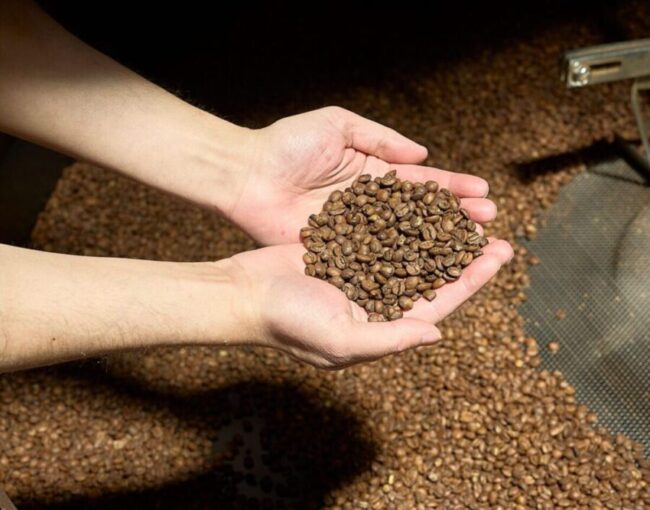Your cart is currently empty!
Learn about our new, blue coffee bags on our blog.
Coffee Freshness

ALL ABOUT FRESHNESS
We find that coffee is best from 2–30 days after roasting, and when used for espresso, it’s best from 7–30 days. Our coffees will still taste good up to 3 months after they’re roasted (and can still be enjoyable even after that), but we don’t suggest shelling out good money for Blueprint Coffee beans that are older than 3 months.
Read on to learn all about freshness in coffee, what we do to ensure freshness, and what you can do at home to keep your coffee fresh.
WHAT IS FRESHNESS?
When we talk about freshness in coffee, we’re usually referring to the qualities of the aromatics (smells) and flavors (tastes) that are present in freshly roasted coffees. These qualities degrade or change over time. Fresh coffees have vibrant, complex, and pleasant aromatics, while coffees that are not fresh will present decreased aromatics, lack of vibrancy, and often staleness or rancidity.
Coffee is an organic material, making it inherently unstable. Changes are constantly occurring in a coffee throughout its life — from growth, to harvest and processing, then roasting and aging. There are two main processes that impact freshness as coffee ages:
- Physical changes: Off-gassing, when CO² dissipates from roasted coffee beans
- Chemical changes: The loss of volatile aromatic compounds (the chemicals that create aromas), and the formation of new compounds that impart off-flavors
PHYSICAL CHANGES: OFF-GASSING
The roasting process creates gases like water vapor, carbon dioxide (CO²), and carbon monoxide (CO) in coffee beans. This gas becomes trapped inside tiny pores throughout the beans, expanding their volume and causing them to crack as they’re roasted. Freshly roasted coffee consists of about 1-2% gas. As coffee ages, its gas gradually releases into the surrounding atmosphere in a process called off-gassing (or de-gassing). Freshly roasted coffees have a much higher concentration of CO² than older coffees.
Gas plays an important role in extraction. When coffee is ground, CO² is rapidly released, and again the moment it’s contacted by water. This creates the “bloom” in filter brewing, and leads to the formation of crema in espresso. Released CO² can also react with water to create carbonic acid — increasing acidity in the cup.
CHEMICAL CHANGES: VOLATILE AROMATIC COMPOUNDS
Aroma in coffee is made up of volatile aromatic compounds, which degrade and disappear over time. This is one of the most immediately noticeable changes in the freshness of coffee. As coffee ages and these compounds dissipate, the vibrant aromas of freshly roasted coffee will fade. Oxidation (reactions with oxygen in the air) can not only cause this loss of freshness but can even create new and unwanted compounds. The oxidation of oils on the surface of coffee beans can create stale or rancid aromas.
A WINDOW OF IDEAL FRESHNESS
A few years ago, Blueprint Coffee conducted our own freshness experiment. We blind tasted a freshly roasted batch of Tektōn every week for six consecutive weeks. These samples were tasted and scored alongside other samples during our normal daily selection and calibration/quality control cuppings. We found that it took one month after the roast date for the coffee to lose one point in score. These results are similar to other industry evaluations that suggest the optimal range of freshness and quality is 3-4 weeks after the roast date.
A note about espresso: Allowing coffee to de-gas for some time before brewing it as espresso can actually be a good thing. We find that aging coffee for a week or two before using it for espresso can help reduce volatility: allowing it time to “settle” can help dial in and pull more consistent shots of espresso. Sometimes when a coffee is too freshly roasted, the volatility of its gases can make it difficult to work with on an espresso bar.
ENEMIES OF FRESHNESS
TEMPERATURE
Higher temperatures speed the chemical reactions that lead to freshness loss.
MOISTURE
Moisture accelerates the loss of volatile organic compounds, leading to aging.
OXYGEN
Oxidation contributes to the loss of volatile organic compounds, and can impart new, unwanted flavors and aromatics like rancidity.
COFFEE DENSITY & ROAST LEVEL
In general, coffees that are less dense and those that are roasted more darkly will generate more CO² and will off-gas more rapidly.
TIME
Coffee is inherently unstable; nothing can keep it fresh forever. Free radicals from roasting will create lipid oxidation even when coffee is stored in a vacuum without oxygen, and off-gassing of CO² will occur no matter what. We must accept that coffee, like everything else in life, simply can’t remain the same forever.
WHAT WE DO
ROASTING
We roast coffee five days a week and do our best to get coffee in your hands as soon as possible. Orders are shipped or locally delivered the day after they’re roasted. In our coffee bars, our practice is to pull any coffee beans off the retail shelf 7 days after they’re roasted. We’ll serve filter brewed coffees up to 14 days after they’re roasted, and espresso up to one month after roast. We ask our wholesale partners to maintain these same standards. No matter where you buy Blueprint Coffee, you can expect the same freshness and quality.
PACKAGING
We package our coffees in sealed, foil-lined bags with a one-way valve. This kind of bag creates an effective barrier to light, moisture, and oxygen. The one-way valve allows air to escape as the coffee releases CO², preventing gas buildup from exploding the bag. And as long as the bag is sealed, the CO² released by the coffee will actually push out air, reducing the concentration of oxygen inside. This keeps coffee fresher, longer.
WHAT YOU CAN DO
STORAGE
Keep your coffee in an airtight container. The bag it came in works just fine — just roll the top back down and use the tin tie to keep it closed. Avoid exposing it to heat and light.
GRIND FRESH
If possible, it’s best to grind your coffee right before brewing. Grinding coffee releases a lot of its CO² and the small pieces of ground coffee have a lot more surface area than whole beans — so they’re a lot more exposed to oxygen. This means that grinding your coffee accelerates its aging process quite a bit.
DON’T OVERSTOCK
Try not to buy too much coffee at once. Our 10 oz or 2 lb bags are a good size for most people brewing at home. Looking for a more convenient way to stay stocked up on fresh coffee beans? Try a subscription!
FREEZE, IF YOU HAVE TO
If you know you won’t be using your coffee for a while, consider freezing it. When you’re ready to use it, simply allow it to come back up to room temperature before brewing as normal.
Sources
Preserving Freshness: A Race Against Time (SCA, 25 Magazine, Issue 4, 2018)
The Coffee Freshness Handbook, Specialty Coffee Association, 2018
